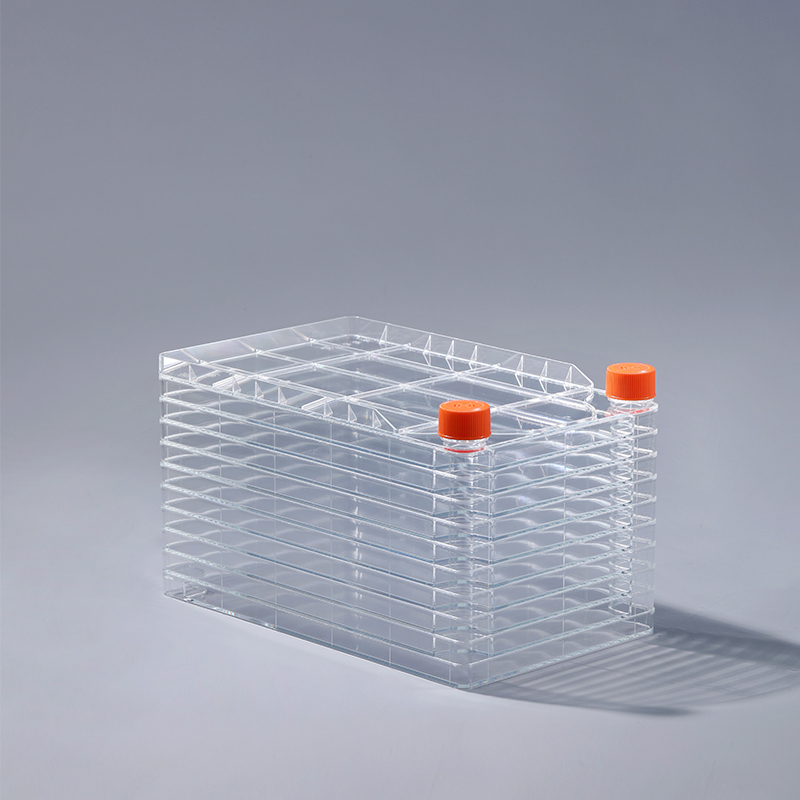je zariadenie na kultiváciu buniek, ktoré sa skladá z jednej alebo viacerých vrstiev podľa veľkosti kultivačnej plochy, ktoré dokáže realizovať kultiváciu buniek vo veľkom meradle a je vhodné pre mnohé oblasti, ako je vakcína, farmaceutický priemysel alebo monomérny klon protilátky. Bunková továreň môže uspokojiť adherentnú bunkovú kultúru a je vhodná aj na statickú kultiváciu suspenzných buniek. Adherentná kultúra znamená, že bunky musia byť pri kultivácii pripevnené k stene kultivačnej (fľaškovej) nádoby. Akonáhle sú bunky pripojené, rýchlo sa rozšíria, potom začnú mitózu a rýchlo vstúpia do logaritmickej rastovej fázy. Vo všeobecnosti o niekoľko dní neskôr sa povrch kultúry pokryje a vytvorí sa hustá bunková monovrstva, ako sú bunky Vero, bunky HEK 293, bunky CAR-T, MRC5, bunky CEF, alveolárne makrofágy ošípaných, myelómové bunky, bunky DF-1, Bunky ST, bunky PK15, bunky Marc145 atď. všetky využívajú metódy adherentnej kultúry. Suspenzná kultúra označuje systém tkanivových kultúr, ktorý kultivuje jednotlivé bunky a malé zhluky buniek v kvapalnom médiu, ktoré sa neustále mieša alebo pretrepáva. Rast suspendovaných buniek nezávisí od povrchu nosiča a rastú v suspendovanom stave v kultivačnom médiu. Napríklad bunky CHO, bunky hmyzu, bunky BHK21 a bunky MDCK sa všetky používajú v suspenznej kultúre. Bunková továreň využíva výhody viacvrstvovej štruktúry a veľkej plochy a je široko používaná v priemyselnej hromadnej výrobe na splnenie požiadaviek dvojité potreby adherentnej kultúry a kultúry suspenzie a je uprednostňovaný mnohými vedecko-výskumnými inštitúciami a farmaceutickými spoločnosťami.cell factory is a cell culture device, which is composed of one or more layers according to the size of the culture area, which can realize the large-scale culture of cells, and is suitable for many fields such as vaccine, pharmaceutical industry or monomer clone antibody.
The cell factory can satisfy adherent cell culture, and it is also suitable for static culture of suspension cells. Adherent culture means that the cells must be attached to the wall of the culture (bottle) vessel when they are cultured. Once the cells are attached, they will spread quickly, then begin mitosis, and quickly enter the logarithmic growth phase. Generally a few days later, the culture surface is covered and a dense cell monolayer is formed, such as Vero cells, HEK 293 cells, CAR-T cells, MRC5, CEF cells, porcine alveolar macrophages, myeloma cells, DF-1 cells, ST cells, PK15 cells, Marc145 cells, etc. all adopt adherent culture methods.
Suspension culture refers to a tissue culture system that cultivates single cells and small cell clusters in a liquid medium that is constantly agitated or shaken. The growth of suspended cells does not depend on the surface of the support, and grows in a suspended state in the culture medium. For example, CHO cells, insect cells, BHK21 cells and MDCK cells are all used in suspension culture.
The cell factory utilizes the advantages of multi-layer structure and large area, and is widely used in industrial mass production to meet the dual needs of adherent culture and suspension culture, and is favored by many scientific research institutions and pharmaceutical companies.
The FAI climbed 5.9 percent year-on-year in the first 11 months of 2018, quickening from the 5.7-percent growth in Jan-Oct, the National Bureau of Statistics (NBS) said Friday in an online statement.
The key indicator of investment, dubbed a major growth driver, hit the bottom in August and has since started to rebound steadily.
In the face of emerging economic challenges home and abroad, China has stepped up efforts to stabilize investment, in particular rolling out measures to motivate private investors and channel funds into infrastructure.
Friday's data showed private investment, accounting for more than 60 percent of the total FAI, expanded by a brisk 8.7 percent.
NBS spokesperson Mao Shengyong said funds into weak economic links registered rapid increases as investment in environmental protection and agriculture jumped 42 percent and 12.5 percent respectively, much faster than the average.
In breakdown, investment in high-tech and equipment manufacturing remained vigorous with 16.1-percent and 11.6-percent increases respectively in the first 11 months. Infrastructure investment gained 3.7 percent, staying flat. Investment in property development rose 9.7 percent, also unchanged.
 English
English



















































